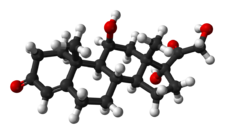Chemistry:Hydrocortisone
 | |
 | |
| Clinical data | |
|---|---|
| Trade names | A-hydrocort, Cortef, Solu-cortef, others[1] |
| Other names | Cortisol; 11β,17α,21-Trihydroxypregn-4-ene-3,20-dione; 11β,17α,21-Trihydroxyprogesterone |
| AHFS/Drugs.com | Monograph |
| MedlinePlus | a682206 |
| License data | |
| Pregnancy category |
|
| Routes of administration | By mouth (tablets), intravenous, topical, rectal |
| Drug class | Corticosteroid; Glucocorticoid; Mineralocorticoid |
| ATC code | |
| Legal status | |
| Legal status | |
| Pharmacokinetic data | |
| Bioavailability | Oral: 96 ± 20%[11][12] |
| Protein binding | 92 ± 2% (92–93%)[11][12] |
| Metabolism | 11β-HSDs, others[12] |
| Metabolites | Cortisone, others[12] |
| Elimination half-life | 1.2–2.0 hours[11][12] |
| Identifiers | |
| |
| CAS Number | |
| PubChem CID | |
| DrugBank | |
| ChemSpider | |
| UNII | |
| KEGG | |
| ChEBI | |
| ChEMBL | |
| Chemical and physical data | |
| Formula | C21H30O5 |
| Molar mass | 362.466 g·mol−1 |
| 3D model (JSmol) | |
| |
| |
| | |
Hydrocortisone is the name for the hormone cortisol when supplied as a medication.[13] Uses include conditions such as adrenocortical insufficiency, adrenogenital syndrome, high blood calcium, thyroiditis, rheumatoid arthritis, dermatitis, asthma, and COPD.[1] It is the treatment of choice for adrenocortical insufficiency.[14] It can be given by mouth, topically, or by injection.[1] Stopping treatment after long-term use should be done slowly.[1]
Side effects may include mood changes, increased risk of infection, and edema (swelling).[1] With long-term use common side effects include osteoporosis, upset stomach, physical weakness, easy bruising, and candidiasis (yeast infections).[1] It is unclear if it is safe for use during pregnancy.[15] Hydrocortisone is a glucocorticoid and works as an anti-inflammatory and by immune suppression.[1]
Hydrocortisone was patented in 1936 and approved for medical use in 1941.[16][17] It is on the World Health Organization's List of Essential Medicines.[18] It is available as a generic medication.[1] In 2020, it was the 149th most commonly prescribed medication in the United States, with more than 3 million prescriptions.[19][20]
Medical uses
Hydrocortisone is the pharmaceutical term for cortisol used in oral administration, intravenous injection, or topical application. It is used as an immunosuppressive drug, given by injection in the treatment of severe allergic reactions such as anaphylaxis and angioedema, in place of prednisolone in patients needing steroid treatment but unable to take oral medication, and perioperatively in patients on long-term steroid treatment to prevent an adrenal crisis. It may also be injected into inflamed joints resulting from diseases such as gout.
It may be used topically for allergic rashes, eczema, psoriasis, itching and other inflammatory skin conditions. Topical hydrocortisone creams and ointments are available in most countries without prescription in strengths ranging from 0.05% to 2.5% (depending on local regulations) with stronger forms available by prescription only.[citation needed]
It may also be used rectally in suppositories to relieve the swelling, itch, and irritation in haemorrhoids.[7]
It may be used as an acetate form (hydrocortisone acetate), which has slightly different pharmacokinetics and pharmacodynamics.[7][21]
-
Cortisol for injection
-
A tube of hydrocortisone cream, purchased over the counter
Pharmacology
Pharmacodynamics
Hydrocortisone is a corticosteroid, acting specifically as both a glucocorticoid and as a mineralocorticoid. That is, it is an agonist of the glucocorticoid and mineralocorticoid receptors.
Hydrocortisone has low potency relative to synthetic corticosteroids. Compared to hydrocortisone, prednisolone is about 4 times as potent and dexamethasone about 40 times as potent in terms of anti-inflammatory effect.[22] Prednisolone can also be used as cortisol replacement, and at replacement dose levels (rather than anti-inflammatory levels), prednisolone is about eight times more potent than cortisol.[23]
The endogenous production rate of cortisol is approximately 5.7 to 9.9 mg/m2 per day, which corresponds to an oral hydrocortisone dose of approximately 15 to 20 mg/day (for a 70-kg person).[24][25]
Pharmacokinetics
Absorption
The bioavailability of oral hydrocortisone is about 96%.[11][12]
The topical percutaneous absorption of hydrocortisone varies widely depending on experimental circumstances and has been reported to range from 0.5 to 14.9% in different studies.[26] Some skin application sites, like the scrotum and vulva, absorb hydrocortisone much more efficiently than other application sites, like the forearm.[26][27][28] In one study, the amount of hydrocortisone absorbed ranged from 0.2% to 36.2% depending on the application site, with the ball of the foot having the lowest absorption and the scrotum having the highest absorption.[28] The absorption of hydrocortisone by the vulva has ranged from 4.4 to 8.1%, relative to 1.3 to 2.8% for the arm, in different studies and subjects.[28][29][30]
Distribution
Most cortisol in the blood (all but about 4%) is bound to proteins, including corticosteroid binding globulin (CBG) and serum albumin. Free cortisol passes easily through cellular membranes.[31] Inside cells it interacts with corticosteroid receptors.[32]
Metabolism
Hydrocortisone is metabolized by 11β-hydroxysteroid dehydrogenases (11β-HSDs) into cortisone, an inactive metabolite.[12] It is additionally 5α-, 5β-, and 3α-reduced into dihydrocortisols, dihydrocortisones, tetrahydrocortisols, and tetrahydrocortisones.[33][12]
Elimination
The elimination half-life of hydrocortisone ranges from about 1.2 to 2.0 hours, with an average of around 1.5 hours, regardless of oral versus parenteral administration.[11][12]
Chemistry
Hydrocortisone, also known as 11β,17α,21-trihydroxypregn-4-ene-3,20-dione, is a naturally occurring pregnane steroid.[34][35] A variety of hydrocortisone esters exist and have been marketed for medical use.[34][35]
Society and culture
Legal status
On 25 March 2021, the Committee for Medicinal Products for Human Use (CHMP) of the European Medicines Agency (EMA) adopted a positive opinion, recommending the granting of a marketing authorization for the medicinal product Efmody, intended for the treatment of congenital adrenal hyperplasia (CAH) in people aged twelve years and older.[36] The applicant for this medicinal product is Diurnal Europe BV.[36] Hydrocortisone (Efmody) was approved for medical use in the European Union, in May 2021, for the treatment of congenital adrenal hyperplasia (CAH) in people aged twelve years and older.[9]
Anti-competitive practices
In the UK, the Competition and Markets Authority (CMA) concluded an investigation into the supply of hydrocortisone tablets, finding that from October 2008 onwards, drug suppliers Auden McKenzie and Actavis plc had charged "excessive and unfair prices" for 10mg and 20mg tablets and entered into agreements with potential competitors, paying companies who agreed not to enter the hydrocortisone market and enabling Auden McKenzie and Actavis to supply the drugs as "generic" rather than branded products and thereby escape price controls until eventually other companies entered the market. Auden and Actavis overcharged the UK's National Health Service for over ten years. Fines totalling over £255m were levied against the companies involved in this breach of competition law.[37]
Research
COVID-19
Hydrocortisone was found to be effective in reducing mortality rate of critically ill COVID-19 patients when compared to other usual care or a placebo.[38]
References
- ↑ 1.0 1.1 1.2 1.3 1.4 1.5 1.6 1.7 "Hydrocortisone". American Society of Health-System Pharmacists. 9 February 2015. https://www.drugs.com/monograph/hydrocortisone.html.
- ↑ "Prescribing medicines in pregnancy database". https://www.tga.gov.au/prescribing-medicines-pregnancy-database.
- ↑ "Hydrocortisone Notice of enforcement policy" (PDF). FDA. https://s3.amazonaws.com/archives.federalregister.gov/issue_slice/1991/8/30/43023-43026.pdf#page=3.
- ↑ "Ala-cort- hydrocortisone cream". https://dailymed.nlm.nih.gov/dailymed/drugInfo.cfm?setid=de000081-a245-4f6b-9e7c-e47d84b82338.
- ↑ "Ala-scalp- hydrocortisone lotion". https://dailymed.nlm.nih.gov/dailymed/drugInfo.cfm?setid=ecba1d44-33a9-44d7-ad06-13ada2375c72.
- ↑ "Alkindi Sprinkle- hydrocortisone granule". https://dailymed.nlm.nih.gov/dailymed/drugInfo.cfm?setid=26c13a5f-7119-4c6a-bf10-fda4e07d7682.
- ↑ 7.0 7.1 7.2 "Anusol HC- hydrocortisone acetate suppository". https://dailymed.nlm.nih.gov/dailymed/drugInfo.cfm?setid=a562f3d7-2692-4357-aade-ae50afcbfddd.
- ↑ "Cortef- hydrocortisone tablet". https://dailymed.nlm.nih.gov/dailymed/drugInfo.cfm?setid=9ce19944-dd88-4a7b-84ca-b07f4ec23bad.
- ↑ 9.0 9.1 "Efmody EPAR". 24 March 2021. https://www.ema.europa.eu/en/medicines/human/EPAR/efmody. Text was copied from this source which is © European Medicines Agency. Reproduction is authorized provided the source is acknowledged.
- ↑ "Efmody Product information". https://ec.europa.eu/health/documents/community-register/html/h1549.htm.
- ↑ 11.0 11.1 11.2 11.3 11.4 "Pharmacokinetics and pharmacodynamics of systemically administered glucocorticoids". Clinical Pharmacokinetics 44 (1): 61–98. 2005. doi:10.2165/00003088-200544010-00003. PMID 15634032.
- ↑ 12.0 12.1 12.2 12.3 12.4 12.5 12.6 12.7 12.8 "Replacement therapy of oral hydrocortisone in adrenal insufficiency: the influence of gastrointestinal factors". Expert Opinion on Drug Metabolism & Toxicology 4 (6): 749–758. June 2008. doi:10.1517/17425255.4.6.749. PMID 18611115.
- ↑ (in en) Principles and Practice of Endocrinology and Metabolism. Lippincott Williams & Wilkins. 2001. p. 762. ISBN 9780781717502. https://books.google.com/books?id=FVfzRvaucq8C&pg=PA762.
- ↑ Tarascon Pocket Pharmacopoeia 2015 Deluxe Lab-Coat Edition. Jones & Bartlett Learning. 2015. p. 202. ISBN 9781284057560.
- ↑ "Hydrocortisone Pregnancy and Breastfeeding Warnings". https://www.drugs.com/pregnancy/hydrocortisone.html.
- ↑ U.S. Patent 2,183,589
- ↑ (in en) Analogue-based Drug Discovery. John Wiley & Sons. 2006. p. 484. ISBN 9783527607495. https://books.google.com/books?id=FjKfqkaKkAAC&pg=PA484.
- ↑ World Health Organization model list of essential medicines: 21st list 2019. Geneva: World Health Organization. 2019. WHO/MVP/EMP/IAU/2019.06. License: CC BY-NC-SA 3.0 IGO.
- ↑ "The Top 300 of 2020". https://clincalc.com/DrugStats/Top300Drugs.aspx.
- ↑ "Hydrocortisone - Drug Usage Statistics". https://clincalc.com/DrugStats/Drugs/Hydrocortisone.
- ↑ "[Comparative study of prednisolone versus hydrocortisone acetate for treatment of patients with the classic congenital adrenal hyperplasia due to 21-hydroxylase deficiency]" (in Portuguese). Arq Bras Endocrinol Metabol 52 (1): 101–8. February 2008. doi:10.1590/s0004-27302008000100014. PMID 18345402.
- ↑ "Dexamethasone". drugs.com. https://www.drugs.com/pro/dexamethasone.html.
- ↑ "One-year clinical evaluation of single morning dose prednisolone therapy for 21-hydroxylase deficiency". Arquivos Brasileiros de Endocrinologia e Metabologia 48 (5): 705–712. October 2004. doi:10.1590/S0004-27302004000500017. PMID 15761542.
- ↑ Cortisol Excess and Insufficiency. Frontiers of Hormone Research. S. Karger AG. 2016. p. 1-PA61. ISBN 978-3-318-05840-6. https://books.google.com/books?id=jew6DAAAQBAJ&pg=RA1-PA61. Retrieved 10 April 2023.
- ↑ Pediatric Adrenal Diseases: Workshop, May 16-18, 2010, Turin (Italy). Karger Medical and Scientific Publishers. 2011. pp. 174–. ISBN 978-3-8055-9643-5. OCLC 1020003143. https://books.google.com/books?id=gde44-zDr_oC&pg=PA174.
- ↑ 26.0 26.1 "Percutaneous absorption of topical corticosteroids". Current Problems in Dermatology 21: 45–60. 1993. doi:10.1159/000422362. ISBN 978-3-8055-5712-2. PMID 8299376.
- ↑ "Effects of anatomical location on in vivo percutaneous penetration in man". Cutaneous and Ocular Toxicology 39 (3): 213–222. September 2020. doi:10.1080/15569527.2020.1787434. PMID 32643443.
- ↑ 28.0 28.1 28.2 "Regional Variation in Percutaneous Absorption". Percutaneous Absorption. CRC Press. 8 June 2021. pp. 165–174. doi:10.1201/9780429202971-11. ISBN 9780429202971.
- ↑ "Human percutaneous penetration of hydrocortisone: the vulva". Archives of Dermatological Research 267 (3): 313–316. 1980. doi:10.1007/BF00403852. PMID 7406539.
- ↑ "Percutaneous absorption of hydrocortisone and testosterone on the vulva and forearm: effect of the menopause and site". The British Journal of Dermatology 134 (2): 229–233. February 1996. doi:10.1111/j.1365-2133.1996.tb07606.x. PMID 8746334.
- ↑ "Bioavailability of oral hydrocortisone in patients with congenital adrenal hyperplasia due to 21-hydroxylase deficiency". The Journal of Endocrinology 169 (1): 65–70. April 2001. doi:10.1677/joe.0.1690065. PMID 11250647.
- ↑ Medical Physiology (2nd ed.). Philadelphia: Saunders. 2011. ISBN 978-1-4377-1753-2.
- ↑ "The role of 5-reduction in physiology and metabolic disease: evidence from cellular, pre-clinical and human studies". The Journal of Steroid Biochemistry and Molecular Biology 207: 105808. March 2021. doi:10.1016/j.jsbmb.2021.105808. PMID 33418075.
- ↑ 34.0 34.1 The Dictionary of Drugs: Chemical Data: Chemical Data, Structures and Bibliographies. Springer. 14 November 2014. pp. 316. ISBN 978-1-4757-2085-3. https://books.google.com/books?id=0vXTBwAAQBAJ&pg=PA316.
- ↑ 35.0 35.1 Index Nominum 2000: International Drug Directory. Taylor & Francis. 2000. pp. 524–. ISBN 978-3-88763-075-1. https://books.google.com/books?id=5GpcTQD_L2oC&pg=PA524.
- ↑ 36.0 36.1 "Efmody: Pending EC decision". 25 March 2021. https://www.ema.europa.eu/en/medicines/human/summaries-opinion/efmody. Text was copied from this source which is © European Medicines Agency. Reproduction is authorized provided the source is acknowledged.
- ↑
 This article incorporates text published under the British Open Government Licence: Competition and Markets Authority, Decision: Hydrocortisone tablets. Excessive and unfair pricing and Anti-competitive agreements, published 31 March 2022, accessed 1 June 2023
This article incorporates text published under the British Open Government Licence: Competition and Markets Authority, Decision: Hydrocortisone tablets. Excessive and unfair pricing and Anti-competitive agreements, published 31 March 2022, accessed 1 June 2023
- ↑ "Association Between Administration of Systemic Corticosteroids and Mortality Among Critically Ill Patients With COVID-19: A Meta-analysis". JAMA 324 (13): 1330–1341. October 2020. doi:10.1001/jama.2020.17023. PMID 32876694.
 |


